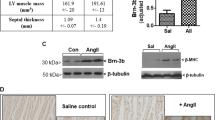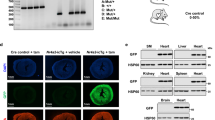Abstract
The early growth response gene Egr-1 is a nuclear transcription factor known to serve as an intermediary in a broad range of signal transduction processes. Recent studies have assigned Egr-1 a new role as an amplifier of gene expression. Egr-1 mRNA is expressed in the myocardium and is rapidly induced in response to hypertrophic stimuli. However, induction of the Egr-1 protein has not yet been demonstrated in the myocardium; on the other hand, in skeletal muscle cells we have shown translational regulation of Egr-1. To further investigate the role of Egr-1 in the regulatory mechanisms of a variety of signal transduction processes we have therefore asked whether bona fide hypertrophic stimuli induce Egr-1 protein subsequently to its mRNA in neonatal rat cardiomyocytes or whether translational block occurs. In confocal laser studies the Egr-1 protein was nuclearly localized. Norepinephrine (NE, 2 μM), angiotensin II (AII, 0.1 μM), and endothelin 1 (E1, 0.1 μM) each induced the Egr-1 mRNA 6-8 fold and the Egr-1 protein 3-5 fold (n = 3, p < 0.01). Therefore, in contrast to skeletal muscle cells, these stimuli increased Egr-1 mRNA and protein levels. These results point further to the role of Egr-1 as a possible amplifier of signal transduction in the myocardium.
Similar content being viewed by others
References
Iwaki K, Sukhatme VP, Shubeita HE, Chien KR: Alpha-and betaadrenergic stimulation induces distinct patterns of immediate early gene expression in neonatal rat myocardial cells. fos/jun expression is associated with sarcomere assembly; Egr-1 induction is primarily an alpha 1-mediated response. J Biol Chem 265: 13809–13817, 1990
Baker KM, Aceto JF: Renin-Angiotensin system involvement in pressure-overload cardiac hypertrophy in rats. Am J Physiol 259: H610–H618, 1990
Shubeita HE, McDonough PM, Harris AN, Knowlton KU, Glembotski CC, Brown JH, Chien KR: Endothelin induction of inositol phospholipid hydrolysis, sarcomere assembly, and cardiac gene expression in ventricular myocytes. A paracrine mechanism for myocardial cell hypertrophy J Biol Chem 265: 20555–20562, 1990
Zierhut W, Zimmer HG: Significance of myocardial alpha-and beta-adrenoceptors in catecholamine-induced cardiac hypertrophy. Circ Res 65: 1417–1425, 1989
Simpson P: Stimulation of hypertrophy of cultured neonatal rat heart cells through an α 1-adrenergic receptor and induction of beating through an α 1-adrenergic receptor interaction: Evidence for independent regulation of growth and beating. Circ Res 56: 884–894, 1985
Bishopric NH, Simpson PC, Ordahl CP: Induction of the skeletal a-actin gene in α 1-adrenoceptor-mediated hypertrophy of rat cardiac myocytes. J Clin Invest 80: 1194–1199, 1987
Waspe LE, Ordahl CP, Simpson P: The cardiac beta-myosin heavy chain isogene is induced selectively in alpha 1-adrenergic receptorstimulated hypertrophy of cultured rat heart myocytes. J Clin Invest 85: 1206–1214, 1990
Simpson P, Savion S: Differentiation of rat myocytes in single cell cultures with an without proliferating nonmyocardial cells: Crossstriations, ultra structure and chronotropic response to isoproterenol. Circ Res 50: 101–116, 1982
Long SC, Ordahl PC, Simpson PC: α1-adrenergic receptor stimulation of sarcomeric actin isogene transcription in hypertrophy of cultured rat heart muscle cells. J Clin Invest 83: 1078–1082, 1989
Neyses L, Nouskas J, Luyken J, Fronhoffs S, Oberdorf S, Pfeifer U, Williams RS, Sukhatme VP, Vetter H: Induction of immediate early genes by angiotensin II and endothelin-1 in adult rat cardiomyocytes. J Hypertension 11: 927–934, 1993
Parker TG, Packer SE, Schneider MD: Peptide growth factors can provoke fetal contractile protein gene expression in rat cardiac myocytes. J Clin Invest 85: 507–517, 1990
Parker TG, Chow KL, Schwartz RJ, Schneider MD: Differential regulation of skeletal alpha-actin transcription in cardiac muscle by two fibroblast growth factors. Proc Natl Acad Sci USA 87: 7066–7070, 1990
Ito H, Hiroe M, Hirata Y, Tsujino M, Acachi S, Shichiri M, Koike A, Nogami A, Marumo F: Insulin-like growth factor-I induces hypertrophy with enhanced expression of muscle specific genes in cultured rat cardiomyocytes. Circulation 87: 1715–1721, 1993
Schwartz K, Chassagne C, Boheler KR: The molecular biology of heart failure. J Am Coll Cardiol 22: 30A–33A, 1993
Sukhatme VP, Cao X, Chang LC, Tsai-Morris C-H, Stamenkovich D, Ferreira PCP, Cohen DR, Edwards SA, Shows TB, Curran T, Le Beau MM, Adamson ED: A zinc finger-encoding gene coregulated with c-fos during growth and differentiation, and after cellular depolarization. Cell 53: 37–43, 1988
Gashler AL, Swaminathan S, Sukhatme VP: A novel repression module, an extensive activation domain, and a bipartite nuclear localization signal defined in the immediate early transcription factor Egr-1. Mol Cell Biol 13: 4556–4571, 1993
Lin JX, Leonard JW: The immediate-early gene product Egr-1 regulates the human Interleukin-2 receptor α-chain promoter through noncanonical Egr and Spl binding sites. Mol Cell Biol 17: 3714–3722, 1997
Lee SL, Sadovsky Y, Swirnhoff AH, Polish JA, Goda P, Gavnilina G, Millbrandt J: Luteinizing hormone deficiency and female infertility in mice lacking the transcription factor NGF-1A (Egr-1). Science 273: 1219–1221, 1996
Maass A, Grohe C, Sukhatme VP, Vetter H, Neyses L: Mitogenic signals control translation of the Early Growth Response Gene-1 in myogenic cells. Biochem Biophys Res Comm 202: 1337–1345, 1994
Chomczynski P, Sacchi N: A single step method of RNA isolation by acid guanidinium thiocyanate-phenol/chloroform extraction. Anal Biochem 162: 156–159, 1987
Cao X, Koski RA, Gashler A, McKiernan M, Morris CF, Gaffney R: Identification and characterization of the Egr-1 gene product, a DNA binding Zinc finger protein induced by differentiation and growth signals. Mol Cell Biol 10: 1931–1939, 1990
Milbrandt J: A nerve growth factor induced gene encodes a possible transcriptional regulatory factor. Science 238: 797–799, 1987
Hong H, Kholi K, Garabedian MJ, Stallcup MR: GRIP1, a transcriptional coactivator for the AF-2 transactivation domain of steroid, thyroid, retinoid, and vitamin D receptors. Mol Cell Biol 17: 2735–2744, 1997
Gupta MP, Gupta M, Zak R, Sukhatme VP: Egr-1, a serum-inducible Zinc finger protein, regulates transcription of the rat cardiac α-myosin heavy chain gene. J Biol Chem 15, 266, 20: 12813–12816, 1991
Khachigian LM, Lindner V, Williams AJ, Collins T: Egr-1 induced endothelial gene expression: A common theme in vascular injury. Science 271: 1427–1431, 1996
Muthukkumar S, Nair P, Sells SF, Maddiwar NG, Jacob RJ, Rangnekar VM: Role of EGR-1 in Thapsigargin-Inducible apoptosis in the melonoma cell line A375-C6. Mol Cell Biol 15: 6262–6272, 1995
Huang RP, Adamson ED: Suppression of v-sis-dependent transformation by the transcription factor, Egr-1. DNA Cell Biol 12: 265–273, 1993
Schunkert H, Sadoshima J, Cornelius T, Kagaya Y, Weinberg EO, Izumo S, Riegger G, Lorell BH: Angiotensin II-induced growth responses in isolated adult rat hearts. Circ Res 76: 489–497, 1995
Amrani FC, Cheaw SL, Chevalier B, Paolaggi F, Jouquey S, Hamon G, Swynghedauw B: Regression of left ventricular hypertrophy by converting enzyme inhibition in 12–15-month-old spontaneously hypertensive rats: Effects on coronary resistance and ventricular compliance in normoxia and anoxia. J Cardiovasc Pharm 23: 155–165, 1994
Bauer WR, Neubauer S, Obitz G, Ertl G: Interrelation of coronary effects of atrial natriuretic peptide and the renin-angiotensin system in the isolated perfused rat heart. J Mol Cell Cardiol 26: 527–537, 1994
Sadoshima J, Xu J, Slayter HS, Izumo S: Autocrine release of angiotensin II mediates stretch-induced hypertrophy of cardiac myocytes in vitro. Cell 75: 977–984, 1993
Zhang X, Dostal DE, Reiss K, Cheng W, Kajstura J, Li P, Huang H, Sonnenblick EH, Meggs LG, Baker KM, Anversa P: Identification and activation of autocrine renin-angiotensin system in adult ventricular myocytes. Am J Physiol 269: H1791–H1802, 1995
Dostal DE, Rothblum KN, Chernin MI, Cooper GR, Baker KM: Intracardiac detection of angiotensinogen and renin: A localized renin-angiotensin system in neonatal rat heart. Am J Physiol 263: C838–C850, 1992
Ishikawa T, Yanagisawa M, Kimura S, Goto K, Masaki T: Positive inotropic action of novel vasoconstrictor peptide endothelin on guinea pig atria. Am J Physiol 255: H979–H973, 1988
Neyses L, Nouskas J, Vetter H: Inhibition of endothelin-1 induced myocardial protein synthesis by an antisense oligonucleotide against the early growth response gene-1. Biochem Biophys Res Comm 181: 22–27, 1991
Zhou QY, Quaife CJ, Palmiter RD: Targeted disruption of the tyrosine hydroxylase gene reveals that catecholamines are required for mouse fetal development. Nature 374: 640–643, 1995
Milano CA, Dolber PC, Rockman HA, Bond RA, Venable ME, Allen LF, Lefkowitz RJ: Myocardial expression of a constitutively active alpha 1B-adrenergic receptor in transgenic mice induces cardiac hypertrophy. Proc Natl Acad Sci 91: 10109–10113, 1994
Author information
Authors and Affiliations
Rights and permissions
About this article
Cite this article
Shamim, A., Palzer, T., Grohé, C. et al. Induction of Egr-1 mRNA and protein by endothelin 1, angiotensin II and norepinephrine in neonatal cardiac myocytes. Mol Cell Biochem 195, 11–17 (1999). https://doi.org/10.1023/A:1006887307568
Issue Date:
DOI: https://doi.org/10.1023/A:1006887307568




